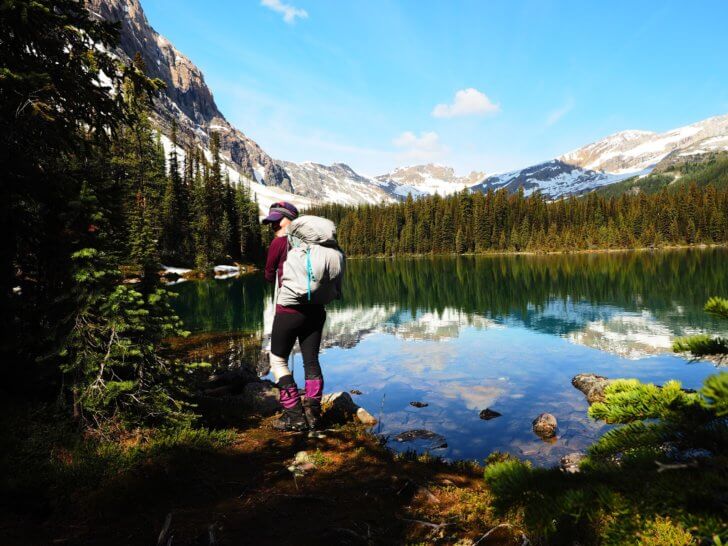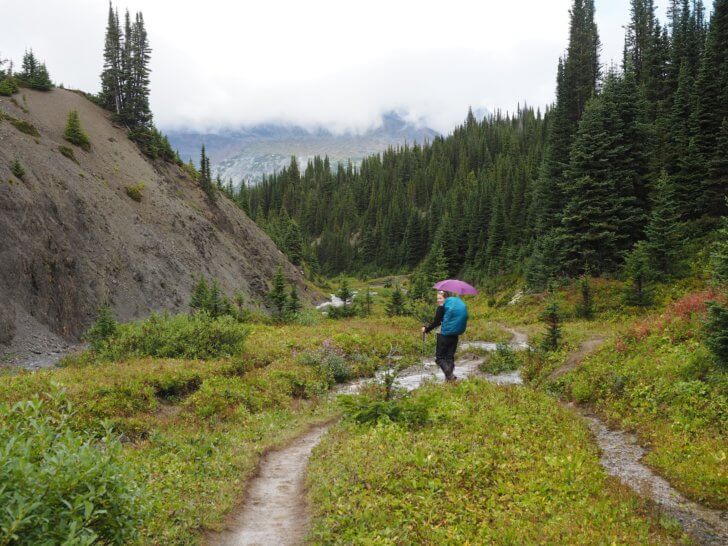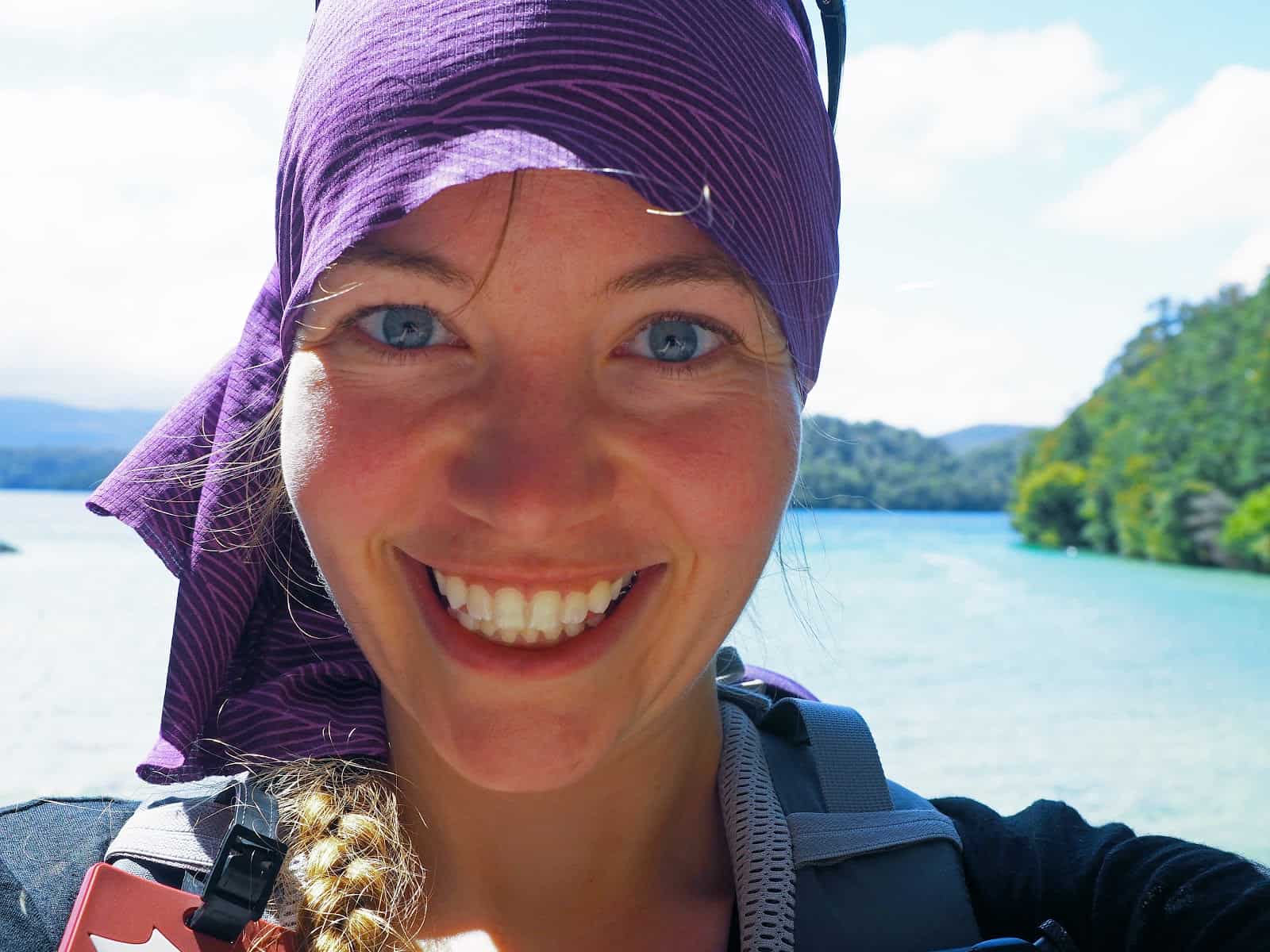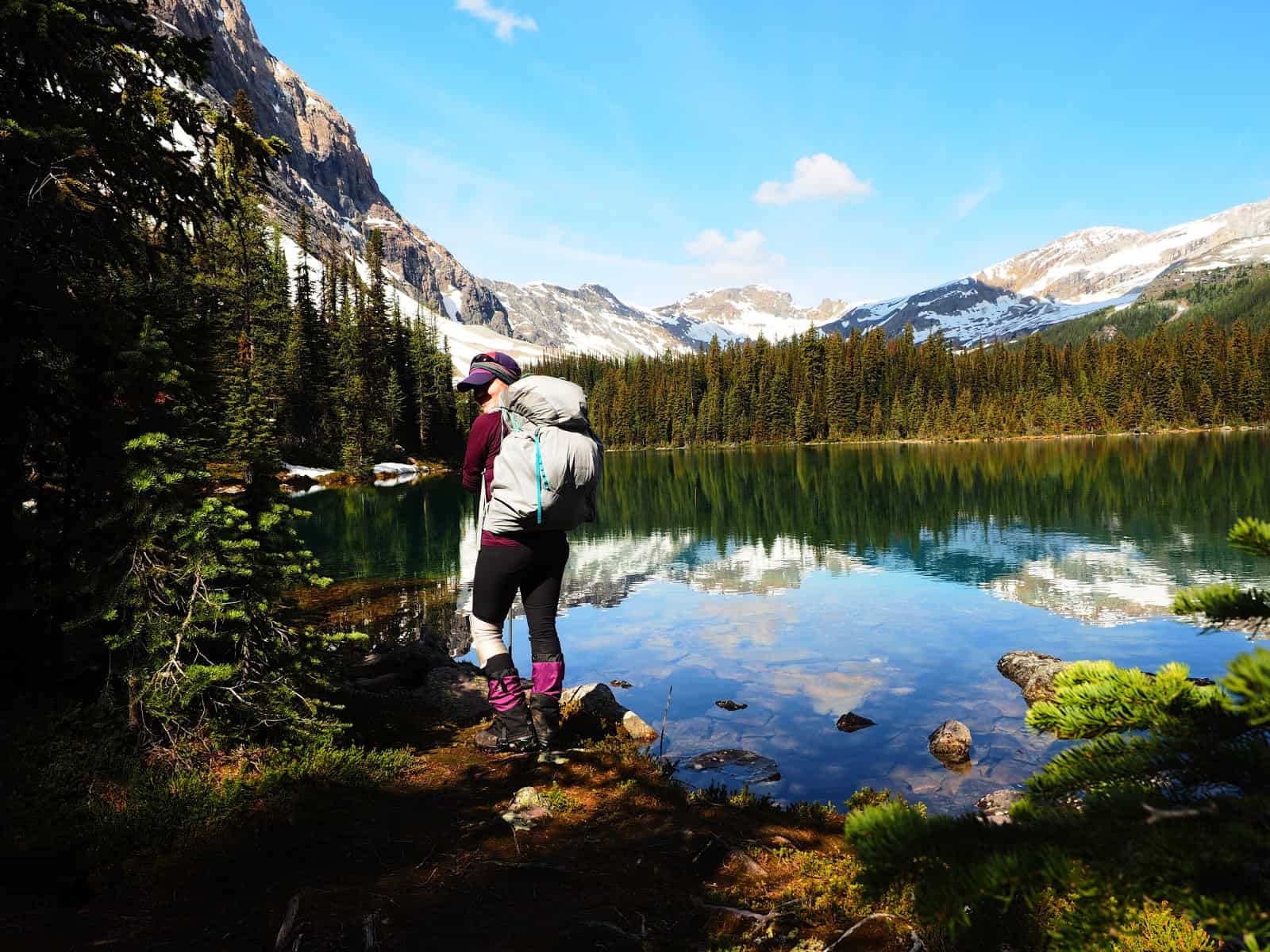Introduction
Though not everyone gets the blistering, itching, inflammation effects of sunburn, skin conditions (including skin cancer and premature aging) are a real possibility for anyone who loves the outdoors. This article considers the gear and supplies you use for lightweight sunscreen protection.
Backpackers who spend extended periods of time in the elements including sunshine are at a higher risk of consequences. Sun protection is crucial to prevent painful sunburn and skin disorders and diseases.
I am melanin challenged – fair-haired, light-eyed, and my skin is a lovely shade of glow-in-the-dark (I have my red-headed mother’s fair complexion). Even if I wasn’t inclined to burn crispy, sun protection should (and would) be a priority for my health.
Do I wear sunscreen every day? No, but I do wear it most days, even when not backpacking. I also cover up most of my exposed skin. I face dire and almost immediate consequences if I don’t protect myself from the sun.
If you get a lovely shade of tan in response to sun exposure, it’s easy to be complacent about sun protection. However, having known a few people under thirty who have lived through skin cancer treatment, I have no desire to join the club and I’m willing to bet that you melanin-challenged readers out there don’t either.
When you face the burning, blistering, and inflammation of a sunburn after an hour or less of sun exposure like I do, you learn a few techniques for saving weight and space while packing sun protection. I will preface by saying that not carrying sun protection is a lighter (but more damaging) option. No dermatologist would recommend anyone skip sun protection and I certainly won’t either.
Cover Up: Lightweight Sunscreen Using the Gear You’re Already Carrying
Perhaps the lightest option is to leverage the clothing you wear as sun protection. When picking layers for backpacking, consider purchasing gear with built-in sun protection or UPF (ultraviolet protection factor). Most outdoor clothing lines have a UPF rating and picking a UPF 50 rated item over a non-rated item rarely costs an extra dime or ounce. Stay away from open-mesh and open-weave fabrics that allow UV light to penetrate through the fabric and onto the skin surface.
Head and Neck
A Buff scarf or tube scarf is worth its weight in versatility and sun protection. A Buff serves as my warm head layer, and my neck, head, chest, and face sun protection in a high UV context. A tube scarf is a light, multi-purpose item every backpacker should consider adding to their pack. Many companies (Outdoor Research UberTubes is my current favorite) offer a cooling fabric with UV blocking tech.
A hat should be obvious, but in case it isn’t, a wide-brimmed hat provides the most shade. A baseball-style cap (front brim only) is not a bad option either, especially in combination with a lightweight hooded shirt or tube scarf.
It is also worth noting, ball caps with sun protection capes around the neck also exist and can be used in place of a tube scarf or hooded scarf. I should note though, a caped ball cap cannot replace the purpose of a tube scarf or a hood in a layering system for inclement weather.

Upper Body
My favorite option is an ultralight wool long-sleeve hoody. Wool doesn’t stink after many days of wear and makes an ideal sun protection layer. I recommend long sleeves and if possible a 3/4 zip with a hood. Summer weight merino (e.g., 150 gsm) is a light-enough option.
Occasionally, in the heat, I find merino a bit itchy, though not itchy enough for me to switch back to synthetic fibers. Whether wool or synthetic, the 3/4-zip, long sleeve, hooded lightweight shirt is my layer of choice for ultralight backpacking because of its multipurpose uses including sun protection.
Lower Body
Shorts and skirts are great for ventilation in the heat, but a lightweight pair of pants in a lighter color is worth the sun, insect, and tick protection during the summer. Vented versions, which provide more cooling and sun protection are probably the best middle ground for those who run hot.
Emylene’s Personal Twist
My final point in sun protection layering is using an umbrella as a parasol. The humble bumbershoot also serves as a cooking shelter and rain layer. It makes a fantastic multipurpose addition to an ultralight pack. In addition to keeping the sun off, I have found an umbrella to be one of the driest, lightest, best vented, and effective rain layers. While rain jackets and pants tend to either saturate or ‘wet out’ (this should really be called a ‘sweat in’) over time during warm rain, umbrellas do not. Obviously, umbrella’s are not ideal for windy conditions, and they provide limited warmth in cold temperatures, but they are an excellent multipurpose item for summer use.

Lightweight Sunscreen Options: Balms, Salves, and Lotions
People always ask about sunscreen lotions. I immensely dislike sunscreen lotions. Sunscreen tends to get everywhere including in my mouth and makes my skin feel terrible. In short, sunscreen tastes, smells, and feels bad. For me, however, sunscreen is a necessary evil. When it comes to sunscreen, I find you generally pick between light, comfortable, or cheap. I am also going to assume readers know about, and have tried normal spray-on and liquid sunscreens and know the ins and outs there.
SPF
Before we dive into lightweight sunscreen options though, let’s chat SPF. What is SPF and what is the ideal SPF?
SPF = Sun Protection Factor
Heather Brannon, MD explains SPF this way: “an SPF rating tells you how long you can stay in the sun without getting burned while wearing that sunscreen, compared with how long you can stay in the sun before you burn without wearing that sunscreen. For example, if it typically takes you 15 minutes to burn without sunscreen and you apply an SPF 10, it will take 10 times longer (2.5 hours) to burn in the sun.”
SPF is not an indication of the effectiveness of sunscreen! It only indicates the length of time it that it’s effective. Medically-recommended sunscreen generally provides 30+ SPF, broad-spectrum (UVA and UVB) protection. Regardless of SPF number, reapplication every 1-2 hours or after sweating or exposure to water is an important best practice.
Lightweight Sunscreen Sticks
One of the most convenient, lightweight sunscreen options is a small stick of solid sunscreen. A lightweight sunscreen stick is usually about the size of a glue stick or about 1/4 to 1/3 the size of a deodorant stick. I find the smell tolerable, the taste intolerable, and the price expensive. Solid sunscreen sticks can usually be purchased for $5 to $15, depending on size. Smaller and lighter sticks can sometimes be found where travel-size toiletries are organized in a store.
My only issue with the sunscreen stick is you cannot measure the exact right amount of the stick and only take the amount you need. The stick is smaller and lighter than liquid but has limitations and because the stick is more viscous (sticky) it does not spread as far as a liquid. My favorite use for sunscreen sticks is during paddling or winter adventures as it conveniently packs into a pocket for on-the-fly application.
Cosmetic Grade Liquid Sunscreen
The most comfortable option for me is a high-end cosmetic cream with sunscreen included as a component. Generally, higher-end cosmetic sunscreens smell pretty good, don’t taste as bad, and absorb into the skin more easily.
Cosmetic sunscreen bottles (often glass) tend to be heavy and breakable. Cosmetic sunscreens can be expensive ($15-$90). When used with proper layering to keep the sun off the price may not be of great concern and the absorption rate means you use much less (and can, therefore, pack less on a trip = weight savings).
Of all the options, a small container (usually not the original container) of higher quality cosmetic grade facial cream with sunscreen built-in is my preference because it’s multipurpose in hydrating windburned skin (without clogging pores and causing breakouts) and acting as a sunscreen. Most of the ladies out there probably have a small and lightweight container of cosmetic sunscreen and have been religiously told to apply it to prevent age spots and wrinkles.
Another tip I can offer here is to use a small, wide mouth, screw off lid container to store the lotion. When you put the lotion in the container put a small piece of plastic wrap over the mouth of the container and screw on the cap. This makes the bottle more leak proof. Keep using the same piece of plastic wrap, it takes quite a while to wear out. As a heads up, this tip works well when airplane traveling with liquids as well.
Sunscreen Wipes
Sunscreen Wipes are like facial cleaning or baby wipes but they have sunscreen built-in. They are easy to apply, don’t count as a liquid during flights and are flammable to use as fire starting material. They are reasonably lightweight and highly packable compared to a liquid solution. However, they also have additional waste associated with their use.
I like sunscreen wipes for when I am flying into my trail location and don’t want to take liquid sunscreen through security or have the bottle leak in my checked gear. Wipes allow you to take exactly the right amount of sunscreen for each day and pack it into meal supplies for applications when you stop to eat.
Foil Packed Liquid Sunscreen
Another sunscreen option (that allows you to pack exactly the right amount of sunscreen): individual foil-packed liquid sunscreen tubes. These are lighter and smaller than a bottle of sunscreen but come with a penalty of a foil package you are stuck with. Foil-packed sunscreen is perfect for getting the exact right amount of sunscreen for a trip and having them easily accessible.
I like the foil packs for precisely dosing my sunscreen on short trips. The foil packs are still lighter than an equivalent bottle (up to a certain point).
Sunscreen Active Ingredients
Sunscreens contain certain ingredients (called active ingredients) that actually do the work of protecting your skin from UV damage. It’s generally accepted (and confirmed by both the American Academy of Dermatology and the Food and Drug Administration) that titanium dioxide and zinc oxide are the safest active ingredients found in sunscreen.
Para-aminobenzoic acid (PABA) and tolamine salicylate are two ingredients that have been deemed unsafe by the FDA. These ingredients are not found in sunscreens legally sold in the US, but you may find them in sunscreens sold elsewhere (especially in developing countries).
Other active ingredients you will commonly find in sunscreens include:
- ensulizole
- octisalate
- homosalate
- octocrylene
- octinoxate
- oxybenzone
- avobenzone
and less commonly:
- cinoxate
- dioxybenzone
- meradimate
- padimate O
- sulisobenzone
It’s important to note that the FDA has not deemed these ingredients safe (nor have they deemed them unsafe!) and FDA has called upon further safety studies to investigate them before providing further public health endorsements (or warnings) about them. The reason for this indecision: some research does exist that poses questions about some of these chemicals…

The Takeaway
Sun protection matters. If you tan or don’t, sun exposure can cause cancer and protecting your skin is worthwhile for preventing premature aging, disease and discomfort. Even if you decide to keep going without sunscreen, at least consider some of the layering sun protection options which don’t add anything to pack weight. Sun protection takes very little time out of a day and has lifelong benefits.
Related Content:
- To read about how the Backpacking Light community deals with sun protection, read this forum thread.
- Are your hands constantly burning? Check out this forum thread on sun gloves.




Home › Forums › Lightweight Sunscreen for Hiking and Backpacking